Ray Tice (ray@x.org)
Mark Welch (mw@x.org)
X Consortium Inc.
February 13, 1996
- Lack of standardized interfaces to audio services
- Lack of standardized network protocols
- Platform independence
- Hardware independence
- Network transparency
- Be all things to all people
- Basic record and playback
- Audio on the web
- Playing synchronized audio/video clips
- Teleconferencing
- Unix and Windows
- Overview
- Time model
- API & code examples
- Security model
- Event model
- Extensions
- Requiring core set of services
- Allowing expansion by layering and extension
- Providing conveniences for targeted applications (make
simple things simple)
- Compression formats
- File formats
- Multicasting
- Time-critical transport
- Device sharing
- Rate & format conversion
- Explicit time model (from AF)
- Synchronization
- Caching of sound clips
- Generalized DSP and filtering
- Complex synchronization constructs
- Generalized analog routing and filtering
- Keep learning curve low
- Make simple things easy
- Make complex things possible
- Organize
- Shield novices from complexity
- Help experts find things
- Client-server, like X11
- Connection based -- uses ICE protocol
- Defined C API, like Xt
- Low-level and convenience services
- Defined network protocol
- Interface with application
- Send requests from client to server
- Receive events from server and dispatch
- Handle file formats
- Move audio data to server
- Provide hardware independent programming model
- Share audio services among clients
- Perform rate & format conversion
- Synchronization
- Access control
- Security proxy handles firewall crossing
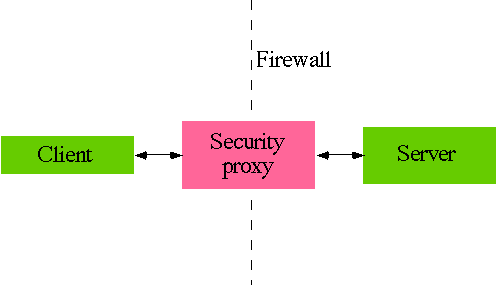
- Model resource allocation in server -- more formal
about objects than X11
- Organize related attributes
- Class (single inheritance)
- Object
- Operations: Create, Destroy, Get, Set, Read, and Write
- Works over client/server connection
- Reduces interface size by using canonical requests
- Applicable to similar problems
- Tuned to meet our specific needs
- File objects
- File players
- Others
- Open audio services
- Create file object (given file name)
- Create player object (given file object)
- Call main loop
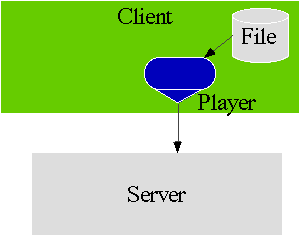
- Represents a piece of input or output hardware
(microphone or speaker and the corresponding ADC or
DAC)
- Does not represent signal processing (DSP)
- Unidirectional
- Client access to buffers/buckets/devices
- Format conversion (decompression / resample / etc.)
- Synchronize source to device time
- Over/underflow policy
- Define characteristics of audio data:
- Encoding (linear, u-law, a-law, etc.)
- Sample rate (8000, 44100, 48000, etc.)
- Other attributes (sample size, number of channels,
endian)
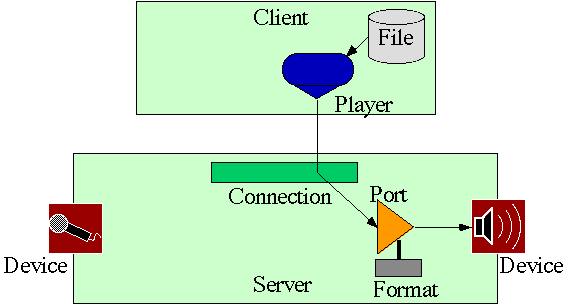
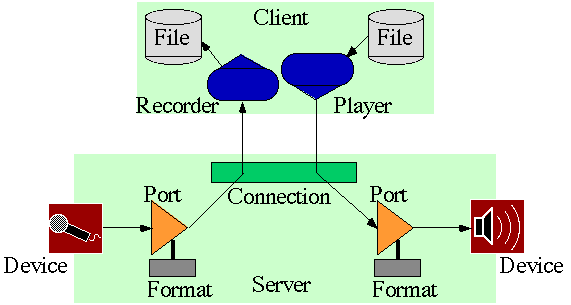

- Security
- Connection management
- A timeline has 1 tick per sample
- Separate timelines for the incoming data stream and
device
- The port object resolves the difference in timelines
- rate conversion
- adding or dropping samples
- Normally, requests arrive ahead of the time at which
they need to be played
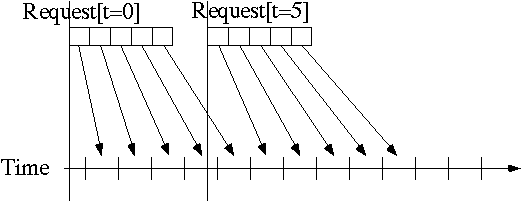
- Two ways of handling transport delay:
1. Stalling
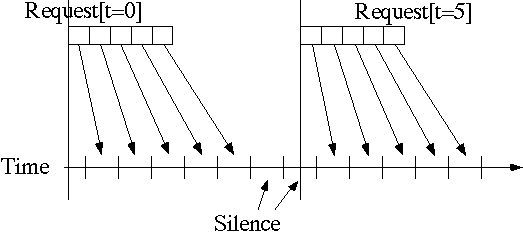

- Low level in first release
- Video or graphics are synchronized to audio
- Inside X server, audio timeline presented as an XSync
counter
- More complex synchronization possible in the future
- Most API encapsulated in 8 basic calls
- Objects referenced by tag, not pointer
- Hides implementation, storage details
- Objects in either client or server
- XaOpenAudio: open a connection
connection = XaOpenAudio(networkID,
argcInOut, argvInOut,
errStringLength, errString);
- XaCloseAudio: shut down a connection
XaCloseAudio(connection);
- XaCreate: create an object
tag = XaCreate(connection,
objectClass, attribute, value,
... );
- XaDestroy: destroy an object
XaDestroy(connection, tag);
- XaSet: set attribute value(s) on an object
XaSet(connection, tag,
asyncCallbackFunc,
asyncCallbackData, attribute,
value, ...);
- XaGet: get attribute value(s) from an object
XaGet(connection, tag,
asyncCallbackFunc,
asyncCallbackData, attribute,
&value, ...);
- XaRead: read audio data from a port
XaRead(connection, port, atTime,
refTime, minBits, maxBits,
&bitsRead, &leftPad, buff);
- XaWrite: write audio data to a port
XaWrite(connection, port, atTime,
refTime, numBits, leftPad, buff);
- Synchronous: blocks until a reply is received
XaGet(connection, object, NULL,
NULL, ...);
- Asynchronous: returns immediately, calls callback when
reply is received
XaGet(connection, object,
callbackFunc, callbackData, ...);
- Locating objects/atoms
- XaFindAtom: Find a name
- XaFindObject: Find an object
- Manage the event queue
- XaPending: Check for pending events
- XaSync, XaCheckpoint: Return when pending
requests are completed
- XaFlush: Flush the event queue
- XaMainLoop: Main loop for audio-only apps
conn = XaOpenAudio("", NULL, NULL,
256, errString);
format = XaFindObject(conn,
XaCformat, XaAname, XaNformatCD);
port = XaCreate(conn, XaCport,
XaNinputBuffer, XaTnone, XaNformat,
format, NULL);
XaWrite(conn, port, 0, XaNnowTime,
numBits, leftPad, audioBuff);
XaClose(conn);
conn = XaOpenAudio("", NULL, NULL,
256, errString);
file = XaCreate(conn, XaCfile,
XaApathName, 3/users/mw/
myFile.au2);
player = XaCreate(conn,
XaCfilePlayer, XaNfile, file,
NULL);
XaMainLoop();
- Broadway security
- Security per connection (trusted/untrusted or other
access group)
- Access control attributes on each connection/device
- Access settings: none, query, read-only, read-write
- May have a GUI
- Not a window manager for audio
- Doesn't run continually
- Presence is not required
- Sets preferences, persistent state
- Configures access for devices/etc.
- Dispatched by event handler objects
- Create / change / destroy object events
- Plays well with Xt
- XaMainLoop or XtMainLoop
- Xa provides function and file descriptor for use with
Xt event functions
- Xa equivalents to Xt basic event commands
handler = XaCreate(connection,
XaCeventHandler,
XaNhandlerProc, (XaArgVal) myFunc,
XaNhandlerData, (XaArgVal) myData,
XaNtargetObject,
myFavoriteClassObject,
XaNeventType, XaAcreate,
NULL);
- May define new protocol requests
- May add new classes
- New devices
- Multicast/radio
- Telephony
- New format encodings...
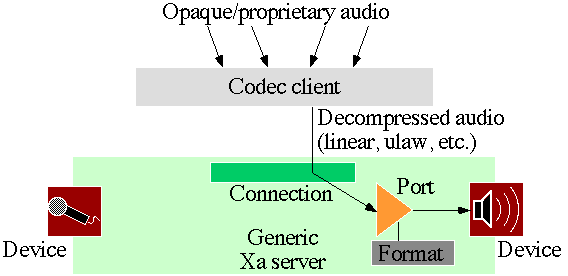
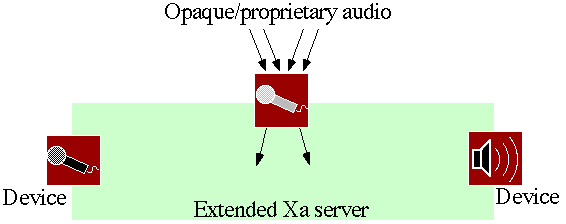
- Flows
- Synchronization/mixing of multiple input streams
- Perform complex processing on streams
- Additional synchronization facilities
- In active development
- Library & protocol specs
- Library, server software
- Consortium standard in time for Broadway
- Implementation release with Broadway
Ray Tice (ray@x.org)
Mark Welch (mw@x.org)
Postscript version of slides:
ftp://ftp.x.org/contrib/conferences/XTech96/audio_slides.ps
Homepage | Broadway
| What is the X Consortium? | X Window System | Membership | Current
Projects | Job Listings & Staff | FTP Public Server









